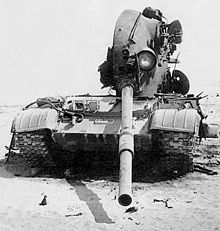Battle of 73 Easting
The main U.S. unit in the battle was the 2nd Armored Cavalry Regiment (2nd ACR), a 4,500 man reconnaissance and security element assigned to VII Corps.
[8] 2nd ACR was to advance east, locate and engage the enemy, determine his dispositions, and then allow the mechanized brigades of 1st ID to pass through to finish destroying the Iraqis.
VII Corps Fragmentary Plan Seven, issued during the night of 25–26 February, made 60 Easting 2nd ACR's initial limit of advance.
All Iraqi units occupied well-constructed defensive emplacements and had prepared alternate positions which enabled them to reorient to the west to face VII Corps's attack.
[17] As part of the 1st Infantry Division (Mechanized) and VII Corps main effort, Task Force 3-37th Armor breached the Iraqi defense on 24 February 1991, clearing four passage lanes and expanding the gap under direct enemy fire.
Colonel Scott Marcy's Third Squadron fought companies of the Iraqi 50th Armored Brigade, which had moved into the regiment's southern area to confirm reports that allied units were in the vicinity.
Third Squadron, operating in the center, destroyed a T-72 tank before 8 am, establishing the first ground contact with the Iraqi Republican Guard's Tawakalna Division.
All three squadrons were in contact with security forces by 9 am but a violent sandstorm blew into the area and movement to the regiment's limit of advance, the 60 Easting, took until 11 am.
Colonel Tony Isaac's First Squadron meanwhile encountered scattered enemy positions in the south and by noon had reported destroying 23 T-55 tanks, 25 armored personnel carriers, six artillery pieces and numerous trucks.
Colonel Roger Jones, and the S2, Major Steve Campbell, briefed him on the situation and informed him that sensors were reporting movement of tracked vehicles to the north out of the regiment's zone.
Lt. General Franks therefore directed the Second Armored Cavalry to continue its attack as far as the 70 Easting and to make contact with the Republican Guard's main defenses and prevent their movement.
At the same time, he ordered the regiment to avoid becoming decisively engaged (meaning to refrain from committing all its maneuver forces and thereby losing freedom of action).
Colonel Holder issued a Fragmentary Order at 3:20 to comply with the Corps Commander's directive and by 3:45 Second Squadron's E and G Troops were in contact with well-organized defenses of the Tawakalna Division.
[14]: 443 [20] Eagle Troop Abrams and Bradleys returned fire, silenced the Iraqi guns, took prisoners, and continued east with the two tank platoons leading.
Taking his platoon of tanks beyond the plumes of smoke, he moved on a Republican Guard motorized rifle company position facing south-southwest, Sartiano lost visual contact with Kilgore’s platoon, As 2nd PLT LT Kilgore’s moved to engage with multiple contacts consisting of T-72s, BMP-1s, and infantry dismounts they found beyond the smoke.
During the fierce six-hour battle, the G Troop fire support team called in 720 howitzer and MLRS rounds, while using its own mortars continually to turn back attackers at close range.
Colonel John Ward, destroyed two batteries of enemy artillery and struck march units along the IPSA Pipeline Road at 16:30, just as the battle began in earnest.
[27][2]: 331 In total, the regimental fire support officer reported employing 1,382 rounds of 155 mm howitzer ammunition (high-explosive, dual-purpose improved munitions and rocket-assisted HE projectiles) and 147 MLRS rockets on 26 February.
The number of enemy infantry casualties caused by indirect fire proved impossible to determine but almost certainly exceeded the thirty infantrymen claimed.
The regiment used artillery fire and some close air support between the end of active fighting and the arrival of the 1st Infantry Division at the line of contact.
Based on the intelligence gained during the battle, Colonel Holder advised the corps commander that the 1st Infantry Division should pass through the southern units of the regiment.
[13] Action continued after nightfall, and by 1840 hours, the ground and air elements of the 3rd AD could report over 20 tanks, 14 APCs, several trucks and some artillery pieces destroyed.
That same evening, the 4th Battalion, 32d Armor lost the division's first casualties in a Bradley Fighting Vehicle to 25mm cannon fire – with two soldiers killed and three wounded.
[citation needed] During the night, both darkness and sandstorms hampered soldiers' visibility, but thermal sighting systems on board the M1A1 Abrams tanks and Bradleys allowed gunners to knock out Iraqi targets.
[35] By 22:30, the battle at 2nd ACR's front, at 74 Easting, was ending with most of the engaged Iraqi elements burning or destroyed as the 1st Infantry Division began its forward passage of lines.
The 1st Infantry Division passed through the 2nd Armored Cavalry Regiment's line in total darkness and continued to advance on Objective Norfolk, an area encompassing the intersection of the IPSA Pipeline Road, several desert trails, and a large Iraqi supply depot.
A slightly disoriented Bradley platoon, attempting to follow the M1 tanks, moved across the front of these Iraqi positions, illuminated by burning vehicles behind them.
[2]: 335 An American tank company trailing the lead units observed the Iraqi fire and joined the melee, quickly destroying three T-55s before they could get off another shot.
The brigade commander, Colonel David Weisman, decided to pull the battalions back, consolidate, and use his artillery to destroy the aggressive Iraqi infantry.
[2]: 377 On this day, a British Army Challenger 1 scored the longest tank-to-tank 'kill' in military history, when it destroyed an Iraqi T-55 at a range of 4.7 km (2.9 miles) with an HESH round.






